In the food industry, hygiene is non-negotiable—any contamination risk can lead to costly product recalls, damaged brand reputation, and even health hazards for consumers. This is where a vacuum conveying system stands out as a game-changer. Unlike traditional mechanical conveyors that have exposed moving parts, gaps, and hard-to-clean areas, vacuum systems operate in a fully enclosed environment. This design prevents dust, debris, and external contaminants from entering the conveying path, keeping food ingredients or finished products pure throughout the process.
For food manufacturers dealing with sensitive materials like flour, sugar, or powdered spices, the enclosed nature of vacuum conveyors also minimizes cross-contamination risks. Even when switching between different ingredients, the system can be easily cleaned and sanitized, adhering to strict food safety standards such as FDA or EU regulations. This not only helps businesses stay compliant but also reduces the likelihood of expensive downtime caused by cleaning or contamination issues. In short, a vacuum conveying system doesn’t just move food—it protects its quality, which is the foundation of customer trust in the food industry.
Efficiency is a key driver of profitability in the food industry, where tight production schedules and high demand require seamless operations. A vacuum conveying system addresses many efficiency pain points that plague traditional conveyor systems. First, its compact design saves valuable floor space in production facilities. Unlike belt conveyors that need to be installed at specific angles or take up large horizontal areas, vacuum systems can be customized to fit around existing equipment, optimizing the use of available space. This is especially beneficial for small to medium-sized food factories where space is at a premium.
Second, vacuum conveyors offer faster and more consistent material transfer. The vacuum’s suction power can be adjusted to handle different types of food materials—from light powders to granular products—without causing spillage or material degradation. This eliminates the need for manual handling, which is not only time-consuming but also increases the risk of human error and injury. For example, a bakery using a vacuum system to convey flour can reduce the time spent on ingredient transfer by up to 30%, allowing the production line to run at full capacity.
Additionally, vacuum conveying systems require less maintenance compared to mechanical conveyors. With fewer moving parts, there’s less wear and tear, meaning fewer breakdowns and less time spent on repairs. This translates to higher uptime for production lines, ensuring that food manufacturers can meet delivery deadlines and keep up with market demand. All these factors combined make a vacuum conveying system a smart investment for businesses looking to boost efficiency and cut operational costs.
Workplace safety is a top priority for any food manufacturer, as accidents can lead to lost productivity, legal liabilities, and harm to employees. Traditional conveying methods, such as bucket elevators or screw conveyors, pose several safety risks—exposed moving parts can cause injuries, and dust accumulation from open systems can create fire or explosion hazards (especially with combustible food dust like sugar or grain dust). A vacuum conveying system mitigates these risks effectively.
The fully enclosed design of vacuum systems eliminates exposed moving parts, reducing the chance of employees getting caught in or injured by the equipment. Moreover, by containing dust within the system, it prevents the formation of dust clouds that could ignite. This is critical in the food industry, where dust explosions are a serious and often underappreciated threat. Many vacuum systems also come with built-in safety features, such as pressure relief valves and dust collection filters, further enhancing workplace safety.
For employees who would otherwise be tasked with manual material handling—such as lifting heavy bags of ingredients or sweeping up spilled dust—vacuum conveyors reduce physical strain. This lowers the risk of musculoskeletal injuries, which are common in the food industry and can lead to long-term absences. By prioritizing employee safety, food manufacturers not only create a better work environment but also reduce the costs associated with accidents and workers’ compensation claims. In this way, a vacuum conveying system contributes to a safer, more sustainable workplace.
In summary, a vacuum conveying system has become popular in the food industry for three core reasons: it guarantees food hygiene, boosts production efficiency, and enhances workplace safety. For food manufacturers, these benefits directly translate to tangible business value—protecting brand reputation through compliant, contamination-free production, increasing profitability via improved efficiency and reduced downtime, and creating a safer workplace that retains employees and minimizes risk.
Whether you’re a small bakery, a large-scale snack manufacturer, or a producer of powdered food products, a vacuum conveying system can be tailored to meet your specific needs. It’s not just a piece of equipment; it’s a solution that addresses the unique challenges of the food industry, helping businesses stay competitive in a market where quality, efficiency, and safety are non-negotiable. By investing in a reliable vacuum conveying system, food manufacturers can future-proof their operations and deliver consistent, high-quality products that meet consumer expectations.

